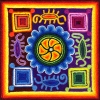Measuring Psychedelic Experience
An Update on Current Projects
Nov 2007
Citation: Baggott M. "Measuring Psychedelic Experience; An Update on Current Projects." Erowid Extracts. Nov 2007;13:9.
I want to briefly update readers on two related projects: analyzing Erowid experience reports and developing an improved psychedelic effects questionnaire. My collaborators and I have been exploring methods of summarizing and quantifying reports in the Erowid Experience Vaults.1 We hope this will help both the users of Erowid and the scientific community to understand the effects of different drugs. We have been getting useful and interesting results examining fifteen different drugs with a technique called independent components analysis. This summer, we presented preliminary results at several conferences. When people describe experiences with a given psychedelic drug, there appear to be consistent themes. Based on these themes we can estimate, for example, how euphoric or anxiety-producing a drug typically is. However, to be confident in our results, we need to compare them to existing questionnaires for measuring mood and other aspects of experience. Collecting these new data takes us to our second related project.
If we are getting people to fill out existing questionnaires about psychedelic experiences, we have a valuable opportunity to try to improve the questionnaires. The questionnaire most commonly used in European psychedelic research is the APZOAV, which measures feelings of "oceanic boundlessness", "dread of ego dissolution", and "visionary restructuralization". It was developed to find the fundamental dimensions of experience that underlie nonordinary states of consciousness. However, some of these allegedly different fundamental dimensions are most obviously different only in terms of mood.
It seems possible that an individual's emotional reaction to the altered state is an independent (and in some ways superficial) aspect overlaid onto more fundamental dimensions of altered states. If this is true, then measuring mood separately could reveal new fundamental aspects about psychedelic states. We plan to test these ideas. In doing so, we hope to develop a questionnaire that more accurately measures psychedelic experience and harmonizes with leading scientific methods of measuring mood, sociability, and mystical experience. We are calling this nascent instrument the EPEQ (pronounced "epic"), or the Erowid Psychedelic Experience Questionnaire. In June, we received approval from our Institutional Review Board to carry out this study and hope to begin soon.
Although these projects are limited in scope, we think of them as part of a larger overarching program of trying to understand psychedelic states. We hope to eventually learn the physical basis and mechanisms of psychedelic experience and how to better shape the experiences. The clinical studies where volunteers are given drugs are an important part of this program and few researchers doing this work receive much attention. But the real experts on psychedelics are the users. If we succeed in understanding psychedelics, it will be the result of projects such as the two described here--projects that collect and make available the knowledge and experiences of psychedelic users. •
If we are getting people to fill out existing questionnaires about psychedelic experiences, we have a valuable opportunity to try to improve the questionnaires. The questionnaire most commonly used in European psychedelic research is the APZOAV, which measures feelings of "oceanic boundlessness", "dread of ego dissolution", and "visionary restructuralization". It was developed to find the fundamental dimensions of experience that underlie nonordinary states of consciousness. However, some of these allegedly different fundamental dimensions are most obviously different only in terms of mood.
It seems possible that an individual's emotional reaction to the altered state is an independent (and in some ways superficial) aspect overlaid onto more fundamental dimensions of altered states. If this is true, then measuring mood separately could reveal new fundamental aspects about psychedelic states. We plan to test these ideas. In doing so, we hope to develop a questionnaire that more accurately measures psychedelic experience and harmonizes with leading scientific methods of measuring mood, sociability, and mystical experience. We are calling this nascent instrument the EPEQ (pronounced "epic"), or the Erowid Psychedelic Experience Questionnaire. In June, we received approval from our Institutional Review Board to carry out this study and hope to begin soon.
Although these projects are limited in scope, we think of them as part of a larger overarching program of trying to understand psychedelic states. We hope to eventually learn the physical basis and mechanisms of psychedelic experience and how to better shape the experiences. The clinical studies where volunteers are given drugs are an important part of this program and few researchers doing this work receive much attention. But the real experts on psychedelics are the users. If we succeed in understanding psychedelics, it will be the result of projects such as the two described here--projects that collect and make available the knowledge and experiences of psychedelic users. •
References #
- Coyle J, Baggott M. "Surfing the Matrix". Erowid Extracts. Jun 2006;10:18.


